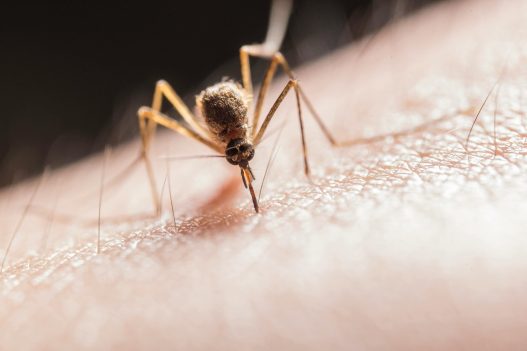Mosquitoes are more than a seasonal annoyance. They carry dangerous viruses, ruin outdoor experiences, and can be tough to get rid of without harsh chemicals. That’s why we’ve compiled 20 effective, natural, and affordable homemade mosquito repellent ideas. Each method includes why it works, a full materials list, and step-by-step instructions for easy application.
Disclaimer: Before using any homemade mosquito repellent, please consult with your healthcare provider, especially if you have known allergies or sensitive skin. Some essential oils and natural ingredients can cause allergic reactions or skin irritation. Discontinue use immediately if you experience redness, itching, or discomfort. Always perform a patch test before applying any new product to larger areas of skin. This information is for educational purposes and does not replace professional medical advice.
1. Lemon Eucalyptus Oil Mosquito Repellent Idea
Why this works: Lemon eucalyptus oil contains PMD (para-menthane-3,8-diol), a natural compound proven to repel mosquitoes. It’s recommended by the CDC as a plant-based alternative to DEET and works by masking body odors and disrupting a mosquito’s ability to detect carbon dioxide and lactic acid. Its slow evaporation provides extended protection, and it has a fresh, clean scent that doesn’t rely on synthetic chemicals.
Materials:
- 10 drops lemon eucalyptus essential oil
- 2 tablespoons witch hazel
- 2 tablespoons distilled water
- Small spray bottle
Instructions:
- Add witch hazel and distilled water to the spray bottle.
- Add lemon eucalyptus oil.
- Shake well before each use.
- Spray directly on skin and clothing.
- Avoid contact with eyes and broken skin.
- Reapply every 3 to 4 hours as needed.
2. Lavender Oil and Vanilla Body Spray

Why this works: Lavender contains linalool, a natural compound with proven insect-repelling properties that mosquitoes actively avoid. Its floral scent is calming to humans but acts as a deterrent to biting insects. When combined with vanilla extract, the formula lasts longer on the skin, extending protection. This blend effectively masks the body odors mosquitoes are drawn to, such as sweat and body heat. It’s gentle enough for children and those with sensitive skin, making it a safer alternative to chemical repellents. As a bonus, it also works as a refreshing and pleasant-smelling body spray.
Materials:
- 10 drops lavender essential oil
- 1 teaspoon pure vanilla extract
- 3 tablespoons distilled water
- Small spray bottle
Instructions:
- Combine lavender oil, vanilla extract, and distilled water in the spray bottle.
- Shake thoroughly before each use.
- Spray on exposed skin, focusing on arms and legs.
- Reapply every 2 to 3 hours when outdoors.
- Store in a cool, dark place.
- Perform a patch test before full use.
3. Apple Cider Vinegar and Essential Oil Mosquito Repellent Idea

Why this works: Apple cider vinegar alters the skin’s pH level and emits an odor that mosquitoes find offensive, making it an effective natural deterrent. When combined with potent essential oils like citronella, tea tree, or peppermint, its efficacy increases by masking human scents mosquitoes are attracted to. It’s non-toxic, safe for most skin types, and can also help soothe existing bites. The solution is cost-effective and simple to prepare at home with pantry staples.
Materials:
- 1/2 cup apple cider vinegar
- 1/2 cup distilled water
- 10 drops citronella oil
- 10 drops tea tree oil
- Small spray bottle
Instructions:
- Mix apple cider vinegar and distilled water in the bottle.
- Add the essential oils.
- Shake well before each application.
- Spray on clothing and exposed skin.
- Avoid spraying on open wounds or sensitive areas.
- Store in the refrigerator for a cooling effect.
4. Peppermint and Coconut Oil Balm
Why this works: Peppermint oil contains menthol, which creates a cooling sensation on the skin and masks the scent of carbon dioxide that attracts mosquitoes. Its strong aroma overwhelms mosquito receptors, making it hard for them to locate you. Coconut oil acts as a natural carrier and helps the peppermint oil stay on the skin longer. It also has minor antibacterial properties that protect bites from becoming infected. This balm is non-greasy, easy to apply, and ideal for spot protection. It’s also suitable for use on children when properly diluted.
Materials:
- 2 tablespoons coconut oil
- 10 drops peppermint essential oil
- Small jar or tin
Instructions:
- Soften coconut oil slightly if solid.
- Mix in the peppermint oil thoroughly.
- Transfer the blend into a clean jar or tin.
- Apply a small amount to wrists, ankles, and neck.
- Reapply every 2 to 3 hours.
- Store in a cool, dry place.
5. Citronella Candle in a Mason Jar
Why this works: Citronella oil is one of the most widely used natural mosquito repellents and works by masking scents that attract mosquitoes, such as carbon dioxide and lactic acid. Burning the oil in a candle form allows the scent to disperse over a larger area. The warmth from the flame intensifies the fragrance, making it more effective outdoors. Mason jars help contain the wax and make it portable. When combined with herbs or citrus peels, the candle becomes even more repellent to bugs. It also doubles as outdoor decor.
Materials:
- 1 cup soy wax flakes
- 15 drops citronella essential oil
- Candle wick
- Mason jar
- Double boiler
Instructions:
- Melt soy wax in a double boiler.
- Add citronella oil and stir gently.
- Place wick in the center of the mason jar.
- Pour melted wax into the jar slowly.
- Let it cool and set for several hours.
- Light during outdoor use to repel mosquitoes.
6. Basil and Witch Hazel Spray
Why this works: Basil naturally emits a scent that mosquitoes dislike due to compounds like estragole and citronellal. It disrupts their sense of smell and makes it harder for them to locate hosts. Witch hazel acts as a skin-safe carrier that preserves the repellent properties of basil extract. The Mosquito Repellent Idea is easy to make, gentle on the skin, and free of synthetic additives. It can also reduce itching from previous bites. The combination makes for a pleasant, earthy-smelling spray.
Materials:
- 1 cup fresh basil leaves
- 1/2 cup boiling water
- 1/2 cup witch hazel
- Small spray bottle
Instructions:
- Steep basil leaves in boiling water for 30 minutes.
- Strain and discard the leaves.
- Mix the basil-infused water with witch hazel.
- Pour into a spray bottle.
- Shake before each use.
- Apply to exposed skin and reapply as needed.
7. Neem Oil Mosquito Repellent Lotion
Why this works: Neem oil contains compounds such as azadirachtin that interfere with mosquito growth and reproduction, effectively reducing their presence. Its strong odor repels mosquitoes and other biting insects. Neem oil also has anti-inflammatory properties that can soothe itchy mosquito bites. When mixed into a lotion, it becomes easy to apply and stays on the skin longer for extended protection. It’s a natural, chemical-free option suitable for all skin types. Regular use can even reduce the frequency of mosquito bites over time.
Materials:
- 2 tablespoons neem oil
- 4 tablespoons unscented lotion or coconut oil
- Small mixing bowl
- Container for storage
Instructions:
- Mix neem oil thoroughly into the unscented lotion or coconut oil.
- Transfer the mixture into a clean container.
- Apply liberally to exposed skin areas.
- Reapply every 4 to 6 hours for best results.
- Store in a cool, dark place.
- Avoid contact with eyes and broken skin.
8. Garlic and Water Mosquito Spray
Why this works: Garlic contains sulfur compounds that mosquitoes find offensive, making it a powerful natural repellent. When applied as a spray, the garlic scent masks the human odors that attract mosquitoes. It also has antifungal and antibacterial properties that help prevent infections from bites. Although the smell is strong to humans as well, it dissipates quickly after application. This spray is easy and inexpensive to make, using ingredients commonly found in most kitchens. It’s a great option for outdoor areas or garden use.
Materials:
- 4 cloves garlic
- 2 cups water
- Spray bottle
Instructions:
- Crush the garlic cloves and soak them in boiling water for 24 hours.
- Strain the garlic pieces out.
- Pour the infused water into a spray bottle.
- Spray around outdoor seating areas or on clothing.
- Avoid spraying directly on skin to prevent irritation.
- Store in the refrigerator and use within a week.
9. Rosemary and Lemon Mosquito Repellent Spray
Why this works: Rosemary contains camphor and cineole, compounds that disrupt mosquito nervous systems and repel them effectively. Lemon adds a fresh citrus scent that mosquitoes avoid. The combined aroma masks human odors, preventing mosquitoes from homing in on potential hosts. Rosemary also has antibacterial and anti-inflammatory benefits, which soothe mosquito bites if contact occurs. This spray is lightweight, non-greasy, and safe for most skin types. It’s perfect for use during outdoor activities or travel.
Materials:
- 1 cup distilled water
- 2 tablespoons dried rosemary or fresh sprigs
- Juice of 1 lemon
- 10 drops lemon essential oil (optional)
- Small spray bottle
Instructions:
- Boil water and steep rosemary for 30 minutes.
- Strain and let cool.
- Add lemon juice and lemon essential oil if using.
- Pour mixture into spray bottle.
- Shake well before each use.
- Apply to skin and clothing; reapply every few hours.
10. Cedarwood and Clove Essential Oil Spray
Why this works: Cedarwood oil contains compounds that disrupt the nervous system of mosquitoes, making it an effective natural repellent. Clove oil is rich in eugenol, a strong scent that mosquitoes find unpleasant and avoid. The combination creates a potent barrier by masking human scents and confusing mosquito sensory receptors. This blend also has antibacterial and antifungal properties that protect skin from irritation. It is long-lasting and safe for most skin types when properly diluted. Using this spray outdoors can significantly reduce mosquito presence.
Materials:
- 10 drops cedarwood essential oil
- 5 drops clove essential oil
- 3 tablespoons distilled water
- 2 tablespoons witch hazel
- Small spray bottle
Instructions:
- Combine distilled water and witch hazel in the spray bottle.
- Add cedarwood and clove essential oils.
- Shake well before each use.
- Spray on exposed skin and clothing.
- Avoid contact with eyes and sensitive skin.
- Reapply every 3 to 4 hours or as needed.
11. Catnip Leaf Infused Oil
Why this works: Catnip contains nepetalactone, a compound proven to repel mosquitoes more effectively than some synthetic repellents. This natural chemical interferes with mosquito receptors, reducing their ability to detect humans. When infused in oil, it can be applied directly to skin or used in diffusers. It also has mild anti-inflammatory properties that help soothe bites. Catnip oil is non-toxic and safe for most skin types, making it ideal for daily use. Its fresh herbal scent is pleasant and less overpowering than other repellents.
Materials:
- 1 cup fresh catnip leaves
- 1 cup carrier oil (such as olive or jojoba oil)
- Glass jar with lid
- Cheesecloth or fine strainer
Instructions:
- Place fresh catnip leaves in the jar and cover with carrier oil.
- Seal tightly and store in a sunny spot for 2 weeks, shaking daily.
- Strain oil through cheesecloth to remove leaves.
- Store infused oil in a dark bottle.
- Apply a small amount to exposed skin areas.
- Reapply every few hours for protection.
12. Cinnamon and Clove Mosquito Repellent Oil
Why this works: Cinnamon oil contains cinnamaldehyde, which repels mosquitoes by disrupting their nervous systems. Clove oil, with its high eugenol content, adds to the repellent strength and masks human odors. Together, they form a powerful natural deterrent with a warm, spicy scent. This blend also has antibacterial qualities that prevent infection from bites. Diluted in a carrier oil, it is safe for topical use and can last several hours on the skin. The combined aroma is more pleasant than harsh chemical repellents.
Materials:
- 5 drops cinnamon essential oil
- 5 drops clove essential oil
- 2 tablespoons carrier oil (coconut, almond, or olive oil)
- Small glass bottle
Instructions:
- Add essential oils to the carrier oil in the glass bottle.
- Shake gently to mix.
- Apply sparingly to wrists, ankles, and neck.
- Avoid use on sensitive skin or near eyes.
- Reapply every 3 hours when outdoors.
- Store in a cool, dark place.
13. Citronella Candle with Essential Oils
Why this works: Citronella oil is widely known for its mosquito-repellent properties due to its ability to mask scents that attract mosquitoes. When combined with other essential oils like lemongrass or peppermint, its effectiveness increases by confusing mosquito sensory receptors. Burning citronella in a candle form releases these oils steadily into the air, creating a protective zone. This method works well for outdoor gatherings or patios where mosquitoes gather. The scent is refreshing and non-toxic, making it safe for people and pets nearby. Using a citronella candle reduces mosquito activity without harsh chemicals.
Materials:
- Soy wax or beeswax
- Citronella essential oil (20-30 drops)
- Lemongrass or peppermint essential oil (10 drops)
- Candle wick
- Candle container or jar
Instructions:
- Melt the wax in a double boiler.
- Remove from heat and stir in essential oils.
- Secure the wick in the container.
- Pour the wax mixture carefully into the container.
- Let it cool and harden completely.
- Light the candle when outdoors to repel mosquitoes.
14. Mint and Rosemary Mosquito Repellent Spray
Why this works: Mint contains menthol, which mosquitoes dislike and avoid, while rosemary’s camphor and cineole interfere with mosquito nervous systems. The combined herbal aromas confuse and deter mosquitoes by masking human scents and disrupting their ability to detect warmth and carbon dioxide. Mint also has a cooling effect on the skin, reducing irritation from bites. Rosemary offers antibacterial properties, helping prevent infection if bitten. This spray is gentle, natural, and safe for most skin types, making it ideal for family use.
Materials:
- 1 cup distilled water
- 1 tablespoon dried rosemary or fresh sprigs
- 10 drops peppermint essential oil
- 10 drops rosemary essential oil
- Small spray bottle
Instructions:
- Boil water and steep rosemary for 30 minutes.
- Strain and allow to cool.
- Add peppermint and rosemary essential oils.
- Pour into a spray bottle and shake well.
- Spray on skin and clothing before going outdoors.
- Reapply every 2 to 3 hours.
15. Basil and Lemon Mosquito Repellent Oil
Why this works: Basil contains eugenol and other compounds that act as natural mosquito repellents by masking human scents and irritating mosquito receptors. Lemon enhances the effect with its citrus scent, which mosquitoes avoid. This combination also offers antibacterial and anti-inflammatory benefits that help soothe skin. When diluted in a carrier oil, it can be applied directly to the skin for a pleasant and effective repellent. The natural scent is refreshing and safe for sensitive skin when properly diluted. This oil is excellent for outdoor use or travel.
Materials:
- 1 cup fresh basil leaves
- 1 lemon (juice and zest)
- 1 cup carrier oil (olive or almond oil)
- Glass jar with lid
Instructions:
- Place basil leaves and lemon zest in the jar.
- Pour carrier oil over the ingredients until covered.
- Seal the jar and let it infuse in sunlight for 1 to 2 weeks.
- Strain the oil to remove solids.
- Add lemon juice before use to freshen the scent.
- Apply oil to exposed skin and reapply as needed.
16. Soy Wax Mosquito Repellent Candle with Citronella and Lavender
Why this works: Soy wax burns cleanly, releasing citronella and lavender essential oils steadily to repel mosquitoes. Citronella masks the human scents mosquitoes are attracted to, disrupting their ability to find hosts. Lavender adds a soothing aroma while also repelling mosquitoes due to its linalool content. The combination creates a pleasant-smelling environment that deters mosquitoes naturally. Soy wax candles burn longer and cleaner than paraffin, making them safer for indoor and outdoor use. This candle also serves as a natural air freshener with therapeutic benefits.
Materials:
- 1 cup soy wax flakes
- 20 drops citronella essential oil
- 10 drops lavender essential oil
- Candle wick
- Candle jar or container
Instructions:
- Melt soy wax flakes in a double boiler until fully liquid.
- Remove from heat and stir in essential oils.
- Attach wick to the bottom of the jar.
- Pour melted wax into the jar carefully.
- Allow to cool and harden completely before lighting.
- Light candle outdoors to keep mosquitoes away.
17. Eucalyptus and Peppermint Spray
Why this works: Eucalyptus oil contains eucalyptol, which mosquitoes find unpleasant and avoid. Peppermint oil contains menthol, a natural insect deterrent that masks human scents and irritates mosquito receptors. Together, they provide a powerful, refreshing, and cooling spray that discourages mosquito bites. Both oils have anti-inflammatory properties that help soothe skin irritation from bites. The spray is lightweight and safe for most skin types when diluted properly. It’s a quick and effective repellent for outdoor activities.
Materials:
- 1/2 cup distilled water
- 10 drops eucalyptus essential oil
- 10 drops peppermint essential oil
- 2 tablespoons witch hazel
- Spray bottle
Instructions:
- Combine water and witch hazel in the spray bottle.
- Add eucalyptus and peppermint oils.
- Shake well before each use.
- Spray on exposed skin and clothing.
- Avoid contact with eyes and broken skin.
- Reapply every 3 to 4 hours for continued protection.
18. Soybean Oil and Essential Oil Repellent
Why this works: Soybean oil acts as a carrier oil that extends the duration of essential oils on the skin. When mixed with oils like citronella, lemongrass, and eucalyptus, it creates a potent, all-natural mosquito repellent. The oils mask the carbon dioxide and lactic acid emitted by the body, confusing mosquitoes. This blend also provides skin nourishment and hydration, reducing irritation. It’s an eco-friendly, safe alternative to chemical repellents and works well for long outdoor exposure. The natural scent is less offensive to humans compared to synthetic sprays.
Materials:
- 1/4 cup soybean oil
- 10 drops citronella essential oil
- 10 drops lemongrass essential oil
- 10 drops eucalyptus essential oil
- Small container
Instructions:
- Mix all ingredients thoroughly in a container.
- Apply a small amount to exposed skin.
- Reapply every 4 hours as needed.
- Store in a cool, dark place.
- Avoid use near eyes and sensitive areas.
- Patch test before first use.
19. Vanilla and Clove Mosquito Repellent Spray
Why this works: Vanilla extract contains compounds that mask the scents mosquitoes use to locate humans, reducing their attraction. Clove oil contains eugenol, a natural repellent that confuses mosquito sensory receptors. The combination creates a sweet, spicy scent that mosquitoes find unpleasant but is enjoyable for people. This blend also provides antibacterial and antifungal benefits, protecting skin from infection. The spray is easy to apply and safe for most skin types when diluted properly. It doubles as a pleasant body mist with protective benefits.
Materials:
- 1/4 cup distilled water
- 1 teaspoon pure vanilla extract
- 10 drops clove essential oil
- Small spray bottle
Instructions:
- Mix distilled water and vanilla extract in the spray bottle.
- Add clove essential oil.
- Shake well before each use.
- Spray on exposed skin and clothing.
- Reapply every 2 to 3 hours.
- Store in a cool, dark place.
20. Camphor and Mint Repellent Balm
Why this works: Camphor has a strong odor that repels mosquitoes by overwhelming their sensory organs. Mint contains menthol which adds a cooling sensation and further masks human scents. When combined in a balm, these ingredients provide long-lasting protection that is easy to apply. The balm also soothes itchy bites and provides a refreshing feel on the skin. It is safe for adults and older children when used externally. This balm is an effective, portable option for quick mosquito relief.
Materials:
- 2 tablespoons beeswax
- 1/4 cup coconut oil
- 10 drops camphor essential oil
- 10 drops peppermint essential oil
- Small container for balm
Instructions:
- Melt beeswax and coconut oil in a double boiler.
- Remove from heat and stir in essential oils.
- Pour mixture into container and let cool until solid.
- Apply balm to exposed skin areas.
- Reapply every 4 to 6 hours as needed.
- Store in a cool, dry place.




















